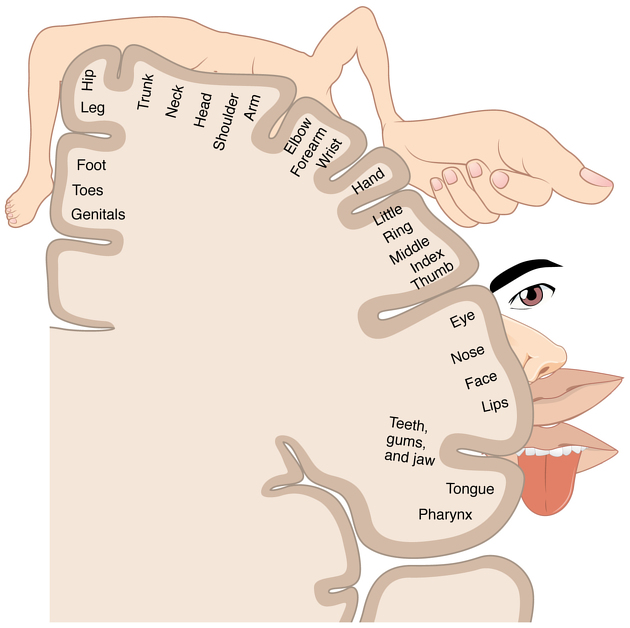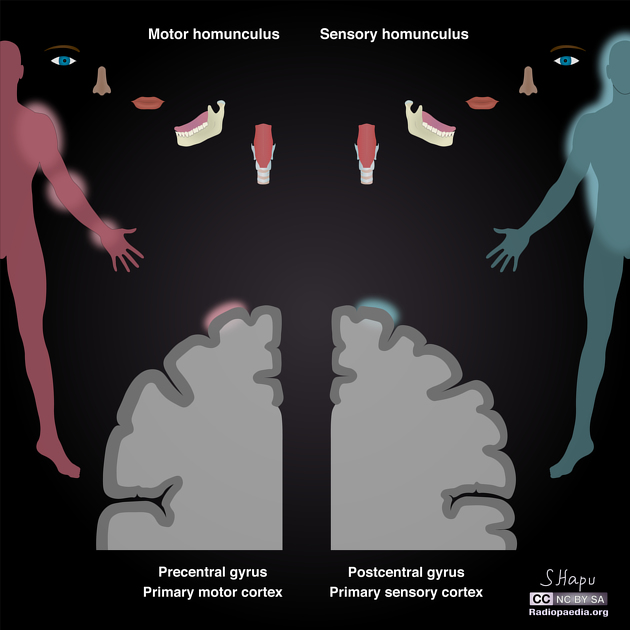Postcentral gyrus
Citation, DOI, disclosures and article data
At the time the article was created Dayu Gai had no recorded disclosures.
View Dayu Gai's current disclosuresAt the time the article was last revised Ayla Al Kabbani had no recorded disclosures.
View Ayla Al Kabbani's current disclosures- Primary somatosensory cortex
- Post central gyrus
The postcentral gyrus lies in the parietal lobe, posterior to the central sulcus. It is the site of the primary somatosensory cortex. The somatosensory homunculus is the representation of the distribution of the contralateral body parts on the gyrus.
On this page:
Blood supply
The main blood supply is from the anterior cerebral artery (ACA) and the middle cerebral artery (MCA).
The medial portion of the postcentral gyrus is supplied by the ACA. The convexity of the postcentral gyrus is supplied by the MCA.
Related pathology
Compromise of either the ACA or MCA blood supply can lead to contralateral sensory deficits as part of ACA syndrome.
Practical points
On sagittal images, the thin postcentral gyrus sign 1 can be used to identify the postcentral gyrus. This sign states that the sagittal width of the postcentral gyrus is thinner than the precentral gyrus. Thus, the thin vertical gyrus and sulcus posterior the central sulcus are the postcentral gyrus and sulcus.
Quiz questions
References
- 1. Naidich TP, Castillo M, Cha S et-al. Imaging of the Brain,Expert Radiology Series,1. Saunders. (2012) ISBN:1416050094. Read it at Google Books - Find it at Amazon
Incoming Links
- Corticobasal degeneration
- White grey sign
- Paracentral lobule
- Inferior parietal lobule
- Central sulcus
- POLG-related disorders
- Supramarginal gyrus
- Creutzfeldt-Jakob disease
- Neonatal hypoxic-ischaemic encephalopathy
- Frontal lobe
- Homunculus
- Operculum
- Brodmann areas
- Superior parietal lobule
- Spetzler-Martin arteriovenous malformation grading system
- Eloquent cortex
- Heschl's gyrus
- Marginal sulcus
- Postcentral sulcus
- Parietal lobe
Related articles: Anatomy: Brain
-
brain
- grey matter
- white matter
-
cerebrum
-
cerebral hemisphere (telencephalon)
- cerebral lobes and gyri
- frontal lobe
- parietal lobe
-
occipital lobe
- occipital pole
- lingual gyrus
- fusiform gyrus (Brodmann area 37)
- calcarine (visual) cortex
- cuneus
- temporal lobe
- basal forebrain
- limbic system
- insula
-
cerebral sulci and fissures (A-Z)
- calcarine fissure
- callosal sulcus
- central (Rolandic) sulcus
- cingulate sulcus
- collateral sulcus
- inferior frontal sulcus
- inferior occipital sulcus
- inferior temporal sulcus
- interhemispheric fissure
- intraparietal sulcus
- lateral (Sylvian) sulcus
- lateral occipital sulcus
- marginal sulcus
- occipitotemporal sulcus
- olfactory sulcus
- paracentral sulcus
- paraolfactory sulcus
- parieto-occipital fissure
- posterior parolfactory sulcus
- precentral sulcus
- preoccipital notch
- postcentral sulcus
- rhinal sulcus
- rostral sulcus
- subparietal sulcus
- superior frontal sulcus
- superior occipital sulcus
- superior temporal sulcus
- cortical histology
- cerebral lobes and gyri
- white matter tracts
- deep grey matter
-
pituitary gland
- posterior pituitary and stalk (part of diencephalon)
- anterior pituitary
- inferior hypophyseal arterial circle
- diencephalon
-
cerebral hemisphere (telencephalon)
-
brainstem
- midbrain (mesencephalon)
- pons (part of metencephalon)
- medulla oblongata (myelencephalon)
- white matter
-
grey matter
- non-cranial nerve
-
cranial nerve nuclei
- oculomotor nucleus
- Edinger-Westphal nucleus
- trochlear nucleus
- motor nucleus of CN V
- mesencephalic nucleus of CN V
- main sensory nucleus of CN V
- spinal nucleus of CN V
- abducent nucleus
- facial nucleus
- superior salivatory nucleus
- cochlear nuclei
- vestibular nuclei
- inferior salivatory nucleus
- solitary tract nucleus
- ambiguus nucleus
- dorsal vagal motor nucleus
- hypoglossal nucleus
-
cerebellum (part of metencephalon)
- vermis
- cerebellar hemisphere
- cerebellar peduncles
- cranial meninges (meninx primitiva)
- CSF spaces
-
cranial nerves (mnemonic)
- olfactory nerve (CN I)
- optic nerve (CN II)
- oculomotor nerve (CN III)
- trochlear nerve (CN IV)
- trigeminal nerve (CN V) (mnemonic)
- abducens nerve (CN VI)
- facial nerve (CN VII) (segments mnemonic | branches mnemonic)
-
vestibulocochlear nerve (CN VIII)
- vestibular ganglion (Scarpa's ganglion)
- glossopharyngeal nerve (CN IX)
- vagus nerve (CN X)
- spinal accessory nerve (CN XI)
- hypoglossal nerve (CN XII)
- functional neuroanatomy
- CNS development
- cerebral vascular supply
- arteries
- vascular territories
-
circle of Willis
- internal carotid artery (ICA) (segments)
- vertebral artery
-
normal variants
- intracranial arterial fenestration
- internal carotid artery (ICA)
- anterior cerebral artery (ACA)
- middle cerebral artery (MCA)
- posterior cerebral artery (PCA)
- basilar artery
- persistent carotid-vertebrobasilar artery anastomoses (mnemonic)
- vertebral artery
- ophthalmic artery
-
cerebral venous system
-
dural venous sinuses
- basilar venous plexus
- cavernous sinus (mnemonic)
- clival diploic veins
- inferior petro-occipital vein
- inferior petrosal sinus
- inferior sagittal sinus
- intercavernous sinus
- internal carotid artery venous plexus of Rektorzik
- jugular bulb
- marginal sinus
- occipital sinus
- sigmoid sinus
- sphenoparietal sinus
- straight sinus
- superior petrosal sinus
- superior sagittal sinus
- torcula herophili
- transverse sinus
-
cerebral veins
-
superficial veins of the brain
- superior cerebral veins (superficial cerebral veins)
- inferior cerebral veins
- superficial middle cerebral vein
- superior anastomotic vein (of Trolard)
- inferior anastomotic vein (of Labbe)
-
superficial veins of the brain
-
deep veins of the brain
- great cerebral vein (of Galen)
- venous circle of Trolard
- normal variants
-
dural venous sinuses
- arteries
- glymphatic pathway









 Unable to process the form. Check for errors and try again.
Unable to process the form. Check for errors and try again.